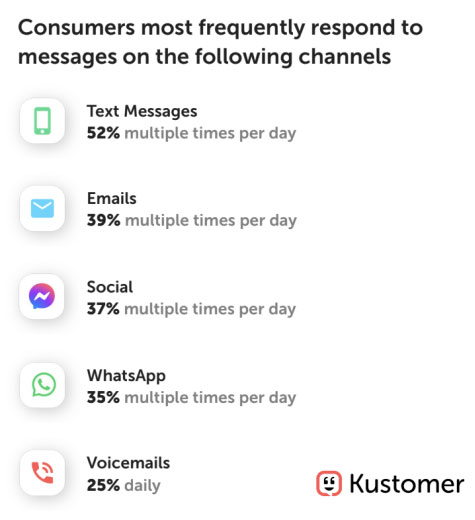How businesses must handle customer interactions is changing as customers adopt messaging as a communication preference. Companies that fail to keep up with the rapid advancements of digitizing this process will be left behind.
Since the pandemic, three times as many companies reported that 80% of their customer interactions are now digital. Therefore, businesses need to start preparing for the ongoing changes digitization is bringing to customer communications.
CRM platform provider Kustomer surveyed more than 3,000 global consumers to understand what changes are on the horizon for the customer experience (CX) landscape. That survey and a study conducted by the University of California at Irvine show a rapid acceptance of modern messaging channels as the pathway for more than just personal messaging.
For instance, the university study found that people check their mobile devices every 43 seconds, which totals 600 times over the typical eight-hour workday. According to researchers, younger generations have become conditioned to look at those little red notifications as soon as they appear.
Using modern messaging channels is becoming a reliable and successful approach for consumers and businesses. The most significant findings in the Kustomer Modern Age of Messaging CX survey illustrate how important it is for brands to deliver a personal, conversational service experience with customers on any channel they prefer, according to Gabe Larsen, head of marketing at Kustomer.
“Otherwise, they run the risk of losing business forever, which can be detrimental in an era when lifetime value (LTV) is more critical than ever,” he told CRM Buyer.
Multiple Channels
How do brands prepare for the future of business conversations to ensure they stay ahead of the curve and stand out from the competition? The survey responses identify one solution — an omnichannel approach. However, Larson cautioned that other options are available, and organizations should not ignore those.
“As it relates to unifying customer interactions across disparate communication channels, an omnichannel solution is an ideal solution. However, these days omnichannel is no longer enough,” he offered.
It is now imperative for organizations to integrate and extract insights quickly to support increasingly complex digital-first transactions. Larsen explained that this allows you to contextualize data to deliver personal support experiences and drive more intelligent processes that scale your business.
“The modern customer no longer wants to be treated like a transaction, especially Gen Z consumers. With the right solution, your agents can devote more time to having meaningful interactions that elevate your customers to feeling as if they are more than just a number in a queue,” Larsen said.
The Role Messaging Plays
Modern messaging strategies are picking up the slack when constantly checking emails creates chronic inbox fatigue. That hinders business conversations, according to the Kustomer CX survey.
By 2025 some 376.4 billion emails will be sent daily worldwide, up by nearly 23% over five years. When measuring average handle time and ensuring that your brand conversations make it through the noise, email may not always be the smartest choice, the Kustomer report suggests.
Survey data shows consumers are more likely to respond to business messages via text rather than email multiple times per day.

The research further shows that business correspondence via social channels is an all-out win for Gen Z consumers.
Checking notifications and responding to messages on social channels is significantly higher for Gen Z consumers than any other age range, with 52% reporting they check their social notifications multiple times a day. Consumers aged 65 and above reported a much lower response at 20%.
Conversely, less than half of Gen Z consumers said they check their email multiple times daily, compared to 72% of consumers over 65.
Critical Findings
The research based on Kustomer CRM platform users’ responses shows that generational preferences continue shifting toward more modern, digital, and instantaneous communication channels.
However, researchers said that just showing up on a channel gets businesses nowhere. The goal while there must be to build long-lasting customer relationships.
Larsen sees significant findings in the survey results. Some of these factors mimic results from similar studies. But this time around, the favorable numbers are more prominent.
The highest response percentage leaves no doubt about the direction businesses must go in establishing their new CX presence. Consider that 89% of consumers think contacting customer service should be easier and more convenient.
An equally eye-opening finding is that 82% of consumers like it when businesses communicate with them in a conversational, friendly manner. Plus, 83% of consumers think they should be able to contact customer service on any channel they choose.
Business executives should focus on this result: 78% of Gen Z consumers have stopped doing business with a brand because they were unavailable on their preferred channel.
Larsen offered a final significant finding which is that 64% of consumers enjoy talking to customer service via the same channels on which they communicate with family and friends.
The following graphic provided by Kustomer lays out a must-do list for remaking or improving corporate thinking on an ideal CX strategy.

These responses indicate a change in direction from the existing “done ticket” interactions and journey toward a more realistic customer relationship that the report recommends.
AI for Agent Relief
Building a better customer experience largely depends on the CRM platform’s flexibility.
Kustomer’s researchers point out that customer service agents spend half of their time searching for information and performing repetitive, manual tasks. This state of affairs lies in the face of the speedy, convenient service customers now demand.
Businesses need to use technology tools and AI that let agents eliminate the menial, repetitive, and time-consuming tasks. The goal is to replace that out-of-date approach with intelligent automation that can detect intent, collect relevant information, automate agent interactions, and route conversation, according to Kustomer.
For instance, intelligent chatbots can deliver contextual and personalized information that feels human. These digital “workers” can seamlessly hand off higher-level, people-required CX tasks to agents when necessary.
“Businesses must ensure they have tools in place that can not only delegate busy work to technology, giving CX agents more time to tackle challenging inquiries but also surface relevant insights to agents, so they are able to deliver personalized and human experiences,” he offered in describing the next phase of customer interactions with businesses.
‘Meta’ Metamorphosis
Kustomer is now part of Meta, the new parent corporation running Facebook. That affiliation might soon play a role in integrating AR/VR solutions for better CX.
“AR/VR technologies have tremendous potential to bring the entire customer experience to life,” noted Larsen.
He added that the relationship between the two entities would help his company deliver faster, richer, and more available CX wherever the customer wants it to be.
In the digital-first economy, businesses and consumers are starting to adopt a new mindset around the role of CX. Customer service agents are no longer simple problem solvers when something goes wrong, suggested Larsen.
“They now build relationships, reflect company values, and even deliver consultative support.”

























































